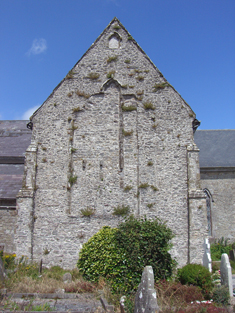
The blocked up great window of the south transept of Cloyne Cathedral. The carved stone that marks the outline of the window is not native to Cloyne or even to Ireland. It was imported from Dundry near Bristol in the thirteenth century. Sadly the great window was crudely blocked up in the middle of the eighteenth century to accommodate the memorials of the Longfield family of nearby Castle Mary.
‘The only part of the building to survive more or less intact from the early Gothic era is the south transept, where there are plenty of original details cut in imported Dundry stone.’
Professor Roger Stalley.
The old phrase ‘coals to Newcastle’ refers to the shipping of coal from Newcastle to London from the seventeenth century. The idea that anyone would ship coal TO Newcastle in the far north of England was so odd that the phrase was used to describe very peculiar behaviour. Yet Ireland, a land rich in stone, imported tons of stone from England during the medieval period! Sometimes, if you know where to look, you can just pick up evidence of the trading links that existed in a place centuries ago. However, some of this evidence may reveal something of the local Irish trading patterns and infrastructure in medieval times.
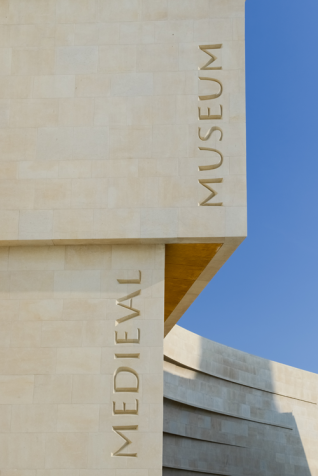
The Waterford Museum of Treasures is the best municipal museum system in Ireland. The medieval museum is a modern building built on the vaulted undercroft of the Choristers’ Hall beside Christchurch Cathedral in Waterford. Dundry stone was used to clad this building in recognition of the original use of the stone for the medieval cathedral. This picture gives a good idea of the pale honey colour of the stone.
Recently I read a fascinating book edited by Professor Roger Stalley of Trinity College Dublin. The book, Irish Gothic Architecture: construction, decay and reinvention, is a collection of excellent research essays on the topic of later medieval Irish architecture, particularly Gothic architecture, although it also looks at nineteenth century perceptions of Gothic architecture. The essays are wonderful, but one made me sit up and go back over it carefully. The reason was the sentence quoted at the top of this post. The essay discussed the building of several cathedrals in Ireland in the thirteenth century, but the discussion of Cloyne Cathedral is important for those interested in south-east Cork. While most of the stonework in the windows of the cathedral has been redone at a later stage, especially in the nineteenth century, those windows in the south transept are original to the building. They were created when the transept was first built in the 1200s.
How did Professor Stalley know this? Well he certainly didn’t consult any surviving documents. Instead he looked at the woindows, especially on the outside, and realized that the stone used to build these windows wasn’t local. But he recognized the stone, nonetheless. It is an oolitic limestone that came from Dundry, a quarry located in the extreme north of Somerset and only a few miles south of Bristol, in the west of England!
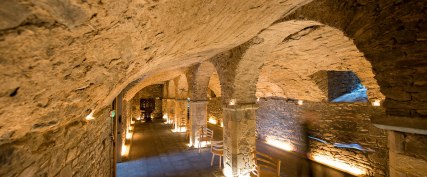
The medieval vaulted undercroft of the Choristers’ Hall in Waterford was built of Dundry Stone. The arcade was inserted later, in the sixteenth or seventeenth century.
Dundry stone was imported into Ireland following the Anglo-Norman invasion of 1169/70. This stone was famously used to build Christchurch Cathedral in Dublin, but in fact, was used in churches from Kinsale in County Cork to Trim in County Meath. It was used for parish churches, monastic churches and cathedrals, but now Cloyne Cathedral joins the list. But why import stone into a country that is already rich in building stone? The most likely reason is that some of the principal masons working on these churches were also English. These English masons came to Ireland because they were familiar with erecting and decorating large stone churches, which were still a fairly new phenomenon in Ireland, having been introduced here just thirty years earlier..
Now these English masons almost certainly came from the West Country of England, for the architecture of Christchurch, Dublin, and other buildings, suggest similarities to some of the architectural features used in the west of England.churches. These masons were entirely familiar with the stone that was available in the west of England.. But in Ireland they discovered that the local stone was different – mostly a hard limestone that the masons found difficult to carve. So they did what the first Norman masons did in England just after the Conquest in 1066 – they imported the stone that they were familiar with. So, just as the earliest Norman masons imported Caen stone for the Tower of London, so the earliest English masons in Ireland imported Dundry stone to make the carved window openings and other decorations. However, by the time the cathedral was built in Cloyne, it is possible that most of the work was done by Irish masons. Sadly, the cathedral accounts do not survive so we really don’t know who built the structure. Whoever they were, they knew about Dundry stone and they chose it for the window openings.
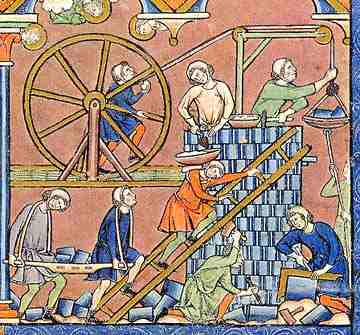
Building the Tower of Babel was a favoured imaged of medieval book illuminators because it depicted the vanity of man. These images are valuable for modern scholars seeking to understand the workings of medieval masons.
But what Stalley does not consider is the implications of importing this stone from England into south-east Cork . This is where economics come into play. Most of the Dundry stone used in Ireland went to places that were accessible by water, being located either on the coast or by a river.The reason this mattered was simple – it just cost too much to freight the stone by cart over land. The more of the stone that could be shipped by water as close as possible to the building site, the cheaper the cost of importing it.
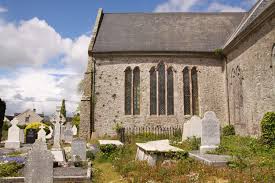
The three eastern windows of the south transept of Cloyne Cathedral are also framed in Dundry stone.
So we need to identify a port that could have been used to import the Dundry stone. Given the economics of moving building stone over land, I would suggest three possible candidates – Ballycotton (directly facing the Bristol Channel, Aghada, the first seat of Robert FitzStephen in Cork and just inside the entrance to Cork Harbour, and Ballinacorra. The first, Ballycotton, presents problems, because it does not seem to have been a major port with the appropriate facilities for offloading heavy cargo. By the time the cathedral was built in Cloyne, Ballycotton seems to have become a fishing village only. Aghada was only used as a caput baroniae (baronial seat) for a short period in the late twelfth century, by 1200 it had been replaced by Ballinacorra. Ballinacorra is much further from the open sea than Aghada, being part of the inner harbour area and possessed ancient links to Cloyne – its ‘great church’ was dedicated to St Colman, suggesting that it was founded directly from Cloyne, probably as a port within Cork Harbour. The present Ballinacorra village is located just a few miles from Cloyne and the terrain is not difficult, so getting shipments of Dundry stone to the cathedral site would have been relatively easy. Remember, only the cut stone was being shipped in – this was a very small amount of the overall amount of stone used in the cathedral. My own opinion, alas not supported by any documentary evidence, is that the Dundry stone for Cloyne came through the port of Ballinacorra.
Sadly, in the middle of the eighteenth century the Longfield family of nearby Castle Mary had the great thirteenth century five light window in the south transept of Cloyne Cathedral crudely blocked up to provide space for their family memorials.
(Note: I exclude Youghal from the above list of ports because it was really only established in the early thirteenth century.)
Reference:Roger Stalley, editior, Irish Gothic Architecture: construction, decay and reinvention. Wordwell Press, Dublin 2012. The quotation at the head of this post is is from the essay by Roger Stalley: ‘Cathedral-building in thirteenth century Ireland,’ contained within the volume. .
Again a very worthwhile read. We do have a wealth of history in our wee part of East Cork….don’t we???
LikeLiked by 1 person
Ellen, our wee part of East Cork has layer upon layer of history. I recall a conversation with Professor Kenneth Nicholls of UCC who was delighted to discover that I came from Imokilly barony. He remarked on the astonishing range of evidence for so many periods of history in the barony, from prehistoric and early Christian to Anglo-Norman, late medieval, early seventeenth century, Restoration, Williamite, eighteenth century and on to the nineteenth and twentieth century. But sadly Irish local history often focuses on very local setting and evidence without setting it into a wider geographical and historical context. For example, how many people are aware of the church at Kilcreden, near Ballymacoda – one of the earliest, if not THE earliest, purpose built Protestant churches in County Cork?
LikeLike
Oh my goodness…..there is a lot there isn’t there??? There are volumes of books to be written on all that, not just blogs. Seriously, a well written and comprehensive history from prehistoric to modern times would be fantastic. It would be very time consuming but wow what a fantastic read it would be. And what a fantastic DOCUMENT, if I dare call it that, it would be to have on the area.
LikeLike
Kilcreden….is that the one with the graveyard. I used to live in Ballymacoda about 30 odd years ago and know the graveyard and church (if this is the one you mean). Didn’t know what denomination it was though. Will you be writing about it any time soon??? Would be very interested in reading all about it if you do.
LikeLiked by 1 person
Ellen, sorry about the late reply! Yes, Kilcreden is the one you recall by Ballymacoda.. There was a medieval church on the site, but in 1635 Sir Robert Tynte (of Tynte’s Castle in Youghal) rebuilt it specifically for the Anglican church. I must do a report on the state of the churches in the early seventeenth century in Imokilly. It makes for dismal reading at times.
LikeLike